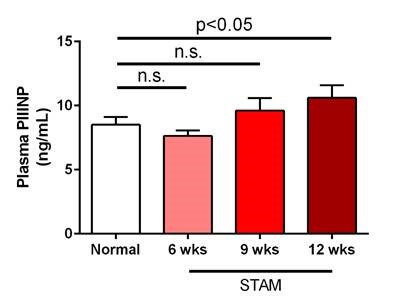Fibrosis markers in the STAM model
We would like to introduce a non-invasive fibrosis marker.
Currently, the most reliable method for MASH diagnosis is histological evaluation through liver biopsy. However, various drawbacks of the liver biopsy method, such as sampling error and burden to patients, have spurred the research and development of non-invasive early-diagnosis markers.
One of these potential markers is Procollagen type III N-terminal peptide (PIIINP), a blood biomarker for fibrosis.
PIIINP is a terminal peptide released during type III collagen synthesis. It is hypothesized that the blood concentration of PIIINP increases with the progression of fibrosis. Clinically, it is suggested as a useful marker to determine between simple steatosis and NASH [Tanwar et al., Hepatology., 2013].
After analysing plasma PIIINP concentration in our proprietary NASH model STAMTM, no statistically significant increase was seen at 6 weeks or 9 weeks of age. However, a significant increase was confirmed at 12 weeks of age.

Although fibrosis is established at 9 weeks of age in the STAMTM model, a significant increase was observed only at 12 weeks of age, when fibrosis was progressed. Therefore, we will continue investigate methods that can detect the onset of fibrosis at an early stage.
We are also investigating the efficacy of various other non-invasive MASH biomarkers, in an effort to offer our clients excellent disease models with high clinical relevance.
As well as STAM™, we have a broad model lineup for a wide range of inflammatory and fibrotic diseases. For more detailed information, please contact us.
